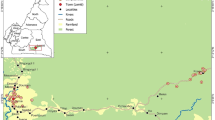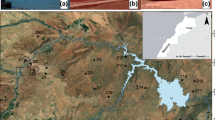Abstract
Legacy tailings from decommissioned mines are known to negatively impact human health and environmental quality. In this study, potentially toxic elements (PTEs) including Cr, Cu, Ni, Pb, and Zn concentrations in tailings from a Selebi-Phikwe mine, Botswana, were assessed for contamination and health risk via multiple exposure pathways in adults and children. Tailings samples from the defunct mine were analyzed for total elemental composition using inductively coupled plasma‒optical emission spectrometry. The results show a decreasing order of mean content of Co (2106 mg/kg) > Ni (1805 mg/kg) > Cr (139 mg/kg) > Co (97 mg/kg) > Zn (53 mg/kg) > Pb (14 mg/kg). The I-geo values show varying degrees of Cr, Cu, Ni, and Zn contamination. Dermal contact (54.5%) was the primary exposure pathway of noncarcinogenic risk for adults, and oral ingestion (95.7%) was the primary exposure route for children. The PTEs posed very low to no noncarcinogenic risks. As a single element, the mean hazard index (HI) for adults and children followed a similar trend: Cr > Cu > Ni > Pb > Zn. However, the carcinogenic risk of Cr, Cu, Ni, and Pb exposure in children was high and unacceptable. For adults, the carcinogenic risks of Cr, Cu, and Ni were high and unacceptable. Overall, children were generally more vulnerable to the adverse effects of PTE exposure. A study of this nature is essential for routine environmental monitoring and assessment and fundamental for planning and reinforcing existing pollution control measures.
Graphical abstract






Similar content being viewed by others
References
Aendo P, Netvichian R, Thiendedsakul P, Khaodhiar S, Tulayakul P (2022) Carcinogenic risk of Pb, Cd, Ni, and Cr and critical ecological risk of Cd and Cu in soil and groundwater around the municipal solid waste open dump in central Thailand. J Environ Public Health 2022:Article ID 3062215
Asare BK, Darkoh MBK (2001) Socioeconomic and environmental impacts of mining in Botswana: a case Study of the Selebi-Phikwe Copper-Nickel Mine. East Afr Soc Sci Res Rev 17(2):1–42
Cao S, Duan X, Zhao X, Wang B, Ma J, Fan D et al (2015) Health risk assessment of various metal(loid)s via multiple exposure pathways on children living near a typical lead-acid battery plant, China. Environ Pollut 200:16–23
Cheng Z, Chen L, Li H, Lin J, Yang Z, Yang Y et al (2018) Characteristics and health risk assessment of heavy metals exposure via household dust from urban area in Chengdu, China. Sci Total Environ 619:621–629
Corzo A, Gamboa N (2018) Environmental impact of mining liabilities in water resources of Parac micro-watershed, San Mateo Huanchor district, Peru. Environ Dev Sustain 20:939–961
de Araújo SN, Ramos SJ, Martins GC, Teixeira RA, de Souza ES, Sahoo PK, Fernandes AR, Gastauer M, Caldeira CF, Souza-Filho PWM et al (2022) Copper mining in the eastern Amazon: an environmental perspective on potentially toxic elements. Environ Geochem Health 44:1767–1781
Ekosse GIE (2008) Environmental effects of nickel–copper exploitation. J Appl Sci 8(13):2344–2356
Ekosse GIE, Ngila JC, Forcheh N (2005) Multivariate analyses of heavy metals in soils and Colophospermum mopane leaves around the Selebi Phikwe nickel-copper mine and smelter/concentrator plant area, Botswana. J Appl Sci Environ Manag 9(1):177–185
Ettler V, Hladíková K, Mihaljevič M, Drahota P, Culka A, Jedlicka R et al (2022) Contaminant Binding and Bioaccessibility in the Dust From the Ni–Cu Mining/Smelting District of Selebi‐Phikwe (Botswana). GeoHealth 6(11):e2022GH000683
Eze PN, Udeigwe TK, Stietiya MH (2010) Distribution and potential source evaluation of heavy metals in prominent soils of Accra Plains, Ghana. Geoderma 156(3–4):357–362
Eze PN, Madani N, Adoko AC (2019) Multivariate mapping of heavy metals spatial contamination in a Cu–Ni exploration field (Botswana) using turning bands cosimulation algorithm. Nat Resour Res 28(1):109–124
Ferreirae-Baptista L, De Miguel E (2005) Geochemistry and risk assessment of street dust in Luanda, Angola: a tropical urban environment. Atmos Environ 39:4501–4512
Gabasiane TS, Danha G, Mamvura TA, Mashifana T, Dzinomwa G (2021) Characterization of copper slag for beneficiation of iron and copper. Heliyon 7(4)
Gall JE, Boyd RS, Rajakaruna N (2015) Transfer of heavy metals through terrestrial food webs: a review. Environ Monit Assess 187:1–21
Gou M, Zhou L, Then NWY (2019) Utilization of tailings in cement and concrete: a review. Sci Eng Compos Mater 26(1):449–464
Han W, Zhao R, Liu W, Wang Y, Zhang S, Zhao K, Nie J (2023) Environmental contamination characteristics of heavy metals from abandoned lead–zinc mine tailings in China. Front Earth Sci 11:1082714
Jefferis K (2016) Economic accounting of mineral resources in Botswana, Technical Report. Gaborone: Wealth Accounting and the Valuation of Ecosystem Services (WAVES), Retrieved from https://naturalcapitalco-alition.org/wp-content/uploads/2016/07/Technical-Rept-WAVES-Botswana-Minerals-pub-5-28-161.pdf
Jiang Y, Chao S, Liu J, Yang Y, Chen Y, Zhang A et al (2017) Source apportionment and health risk assessment of heavy metals in soil for a township in Jiangsu Province, China. Chemosphere 168:1658–1668
Jiang L, Sun H, Peng T, Ding W, Liu B, Liu Q (2021) Comprehensive evaluation of environmental availability, pollution level and leaching heavy metals behavior in nonferrous metal tailings. J Environ Manag 290:112639
Johnson RH, Robertson WD, Molson JW (1994) Acid-neutralization reactions in inactive mine tailings impoundments and their effect on the transport of dissolved metals. Proc Am Soc Min Reclam 429–438
Kan X, Dong Y, Feng L, Zhou M, Hou H (2021) Contamination and health risk assessment of heavy metals in China’s lead–zinc mine tailings: a meta–analysis. Chemosphere 267:128909
Kebonye NM, Eze PN (2019) Zirconium as a suitable reference element for estimating potentially toxic element enrichment in treated wastewater discharge vicinity. Environ Monit Assess 191:1–15
Kebonye NM, Eze PN, Akinyemi FO (2017) Long term treated wastewater impacts and source identification of heavy metals in semi-arid soils of Central Botswana. Geoderma Reg 10:200–214
Kebonye NM, Eze PN, John K, Gholizadeh A, Dajčl J, Drábek O, Němeček K, Borůvka L (2021) Self-organizing map artificial neural networks and sequential Gaussian simulation technique for mapping potentially toxic element hotspots in polluted mining soils. J Geochem Explor 222:106680
Kebonye NM, Eze PN, Agyeman JK, PC, Němeček K, Borůvka L (2022) An in-depth human health risk assessment of potentially toxic elements in highly polluted riverine soils Příbram, (Czech Republic). Environ Geochem Health 44(2):369–385
Kumar V, Sharma A, Kaur P, Sidhu GPS, Bali AS, Bhardwaj R et al (2019) Pollution assessment of heavy metals in soils of India and ecological risk assessment: a state-of-the-art. Chemosphere 216:449–462
Likuku AS, Mmolawa KB, Gaboutloeloe GK (2013) Assessment of heavy metal enrichment and degree of contamination around the copper-nickel mine in the Selebi Phikwe Region, Eastern Botswana. Environ Ecol Res 1(2):32–40
Manyiwa T, Ultra VU, Rantong G, Opaletswe KA, Gabankitse G, Taupedi SB, Gajaje K (2021) Heavy metals in soil, plants, and associated risk on grazing ruminants in the vicinity of Cu–Ni mine in Selebi-Phikwe, Botswana. Environ Geochem Health 1–16
Martin V, Bussière B, Plante B, Pabst T, Aubertin M, Medina F et al (2017) Controlling water infiltration in waste rock piles: design, construction, and monitoring of a large-scale in situ pilot test pile. GEO Ottawa 2017
Molale TL, Eze PN (2023) Human geophagy (soil ingestion): biochemical functions and potential health implications. In: Adewoyin Y (eds) Health and medical geography in Africa. Global perspectives on health geography. Springer, Cham. https://doi.org/10.1007/978-3-031-41268-4_17.
Motswaiso F, Wang J, Nakamura K, Watanabe N, Komai T (2022) A geochemical approach for source apportionment and environmental impact assessment of heavy metals in a Cu–Ni mining region, Botswana. Environ Earth Sci 81(5):1–14
Müller G (1969) Index of geoaccumulation in sediments of the Rhine River. GeoJournal 2:108–118
Peng Y, Hu J, Li Y et al (2018) Exposure to chromium during pregnancy and longitudinally assessed fetal growth: findings from a prospective cohort. Environ Int 121:375–382
Rambabu K, Bharath G, Banat F, Show PL (2020) Biosorption performance of date palm empty fruit bunch wastes for toxic hexavalent chromium removal. Environ Res 187:109694
Rashed MN (2010) Monitoring of contaminated toxic and heavy metals, from mine tailings through age accumulation, in soil and some wild plants at Southeast Egypt. J Hazard Mater 178:739–746
Rollin HB (2011) Manganese: environmental pollution and health effects. In: Nriagu JO (ed) Encyclopedia of environmental health. Burlighton, Elsevier, Johannesburg, pp 216–629
Rubinos DA, Óscar J, Forghani G, Edraki M, Kelm U (2021) Geochemical stability of potentially toxic elements in porphyry copper-mine tailings from Chile as linked to ecological and human health risks assessment. Environ Sci Pollut Res 28:57499–57529
Sánchez-Donoso R, Martín-Duque JF, Crespo E, Higueras PL (2019) Tailing’s geomorphology of the San Quintín mining site (Spain): landform catalogue, aeolian erosion and environmental implications. Environ Earth Sci 78(5):1–17
Schwartz MO, Kgomanyane J (2008) Modelling natural attenuation of heavy-metal groundwater contamination in the Selebi-Phikwe mining area, Botswana. Environ Geol 54:819–830
SEPAC (State Environmental Protection Administration of China) (2013) Exposure factors handbook of Chinese population. China Environmental Science Press, Beijing (in Chinese)
USEPA (1989) Risk assessment guidance for superfund: volume I: Human health evaluation manual (Part A). Office of Solid Waste and Emergency Response. US Environmental Protection Agency, Washington, DC, USA
USEPA (2001) Supplemental guidance for developing soil screening levels for superfund sites. US Environmental Protection Agency, Washington, DC, USA
USEPA (2002) Supplemental guidance for developing soil screening levels for superfund sites. US Environmental Protection Agency, Washington, DC, USA
USEPA (2004) Risk assessment guidance for superfund: volume I: human health evaluation manual. Office of Superfund Remediation and Technology Innovation, Washington, DC, USA
USEPA (2011) Exposure factors handbook (final report). US Environmental Protection Agency, Washington, DC
Venza M, Visalli M, Biondo C, Oteri R, Agliano F, Morabito S et al (2015) Epigenetic marks responsible for cadmium-induced melanoma cell overgrowth. Toxicol in Vitro 29(1):242–250
Xiao X, Zhang J, Wang H, Han X, Ma J, Ma Y, Luan H (2020) Distribution and health risk assessment of potentially toxic elements in soils around coal industrial areas: a global meta-analysis. Sci Total Environ 713:135292
Yin G, Li G, Wei Z, Wan L, Shui G, Jing X (2011) Stability analysis of a copper tailings dam via laboratory model tests: a Chinese case study. Min Eng 24(2):122–130
Zhang W, Alakangas L, Wei Z, Long J (2016) Geochemical evaluation of heavy metal migration in Pb–Zn tailings covered by different topsoils. J Geochem Explor 165:134–142
Zhang X, Wu Q, Gao S, Wang Z, He S (2021) Distribution, source, water quality and health risk assessment of dissolved heavy metals in major rivers in Wuhan, China. PeerJ 9:e11853
Author information
Authors and Affiliations
Corresponding author
Additional information
Editorial responsibility: Shah Fahad.
Rights and permissions
Springer Nature or its licensor (e.g. a society or other partner) holds exclusive rights to this article under a publishing agreement with the author(s) or other rightsholder(s); author self-archiving of the accepted manuscript version of this article is solely governed by the terms of such publishing agreement and applicable law.
About this article
Cite this article
Kouadio, W.N., Bineli-Betsi, T., Yendaw, J. et al. Human health risks from multiple exposure pathways of potentially toxic elements in nickel–copper mine tailings, Central Botswana. Int. J. Environ. Sci. Technol. (2024). https://doi.org/10.1007/s13762-024-05546-3
Received:
Revised:
Accepted:
Published:
DOI: https://doi.org/10.1007/s13762-024-05546-3




